
The 8th Panzer Division was a formation of the WehrmachtHeer. The division was formed by reorganising the 3rd Light Division in October 1939. It was transferred to the west and fought in the Battle of France, in May 1940, and the German invasion of the Balkans in April 1941. Soon after the division advanced towards Leningrad under Army Group North in Operation Barbarossa, and would remain on the eastern front for the remainder of the war. Staying on defensive fronts, it saw action in the relief of Kholm in 1942, Orel and the withdrawals of Army Group Centre in 1943, until transferred to Army group South. The division then fought in a series of retrograde movements, back through Ukraine, into Hungary and finally into Silesia and surrender in May 1945.
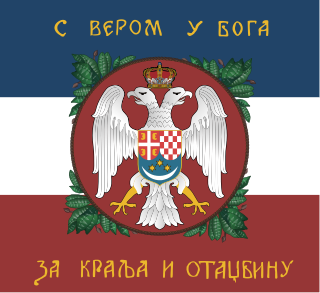
The Yugoslav Army, commonly the Royal Yugoslav Army, was the land warfare military service branch of the Kingdom of Yugoslavia. It existed from the Kingdom's formation in December 1918, until its surrender to the Axis powers on 17 April 1941. Aside from fighting along the Austrian border in 1919–20 related to territorial disputes, and some border skirmishes on its southern borders in the 1920s, the JV was not involved in fighting until April 1941 when it was quickly overcome by the German-led invasion of Yugoslavia.

The 25th Infantry Division was a military unit of the German Wehrmacht. It was later reclassified to 25th Infantry Division (mot.), and in June 1943 to the 25th Panzer Grenadier Division.

Ludwig Kübler was a German General der Gebirgstruppe who commanded the 1st Mountain Division, XXXXIX Mountain Corps, 4th Army and the Operational Zone of the Adriatic Littoral during World War II. He was awarded the Knight's Cross of the Iron Cross for his actions commanding the 1st Mountain Division during the invasion of Poland in 1939. He also commanded the division during the invasion of France and the Low Countries before being appointed to command XXXXIX Mountain Corps. During his command of this corps it was involved in the invasion of Yugoslavia and the attack on the Soviet Union. In December 1941 he was appointed to command the 4th Army, but was dismissed from this post in January of the following year, and placed in the Führerreserve des Heeres. In September 1943 he was appointed as the commanding general of security troops for Army Group Centre on the Eastern Front, but the following month he was appointed to command the Operational Zone of the Adriatic Littoral, based at Trieste on the northern Adriatic coast. After being captured by Yugoslav forces at the end of the war, he was tried and executed for war crimes.
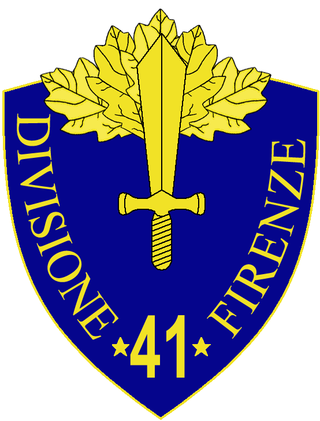
The 41st Infantry Division "Firenze" was an infantry division of the Royal Italian Army during World War II. The Firenze was formed on 15 September 1939 in Florence and named for the city. The division recruited primarily in Tuscany. After the announcement of the Armistice of Cassibile on 8 September 1943 the division resisted German attempts to disbanded it and on 28 September 1943 the division dissolved itself and formed partisan formations, which joined the Albanian National Liberation Army.

The 31st Infantry Division was a German infantry division of the Army during World War II. It participated in the invasion of Poland in 1939 then the invasion of France and the Low Countries in 1940. As part of Panzergruppe 2. of Army Group Centre, it was involved in the invasion of the Soviet Union in June 1941. After hard fighting throughout 1941 and 1942 it joined the 9th Army and fought in the Battle of Kursk in July and August 1943. Along with the rest of the 9th Army, the division conducted a fighting withdrawal for the remainder of 1943, during which it sustained heavy casualties. In the early stages of the Soviet Operation Bagration of June to August 1944, the 31st Infantry Division was destroyed, a fate which subsequently befell most of Army Group Centre. The division was officially disbanded on 18 July 1944.

The 373rd (Croatian) Infantry Division was a division of the German Army during World War II. It was formed in June 1943 using a brigade from the Home Guard of the Independent State of Croatia with the addition of a German cadre. The division was commanded by Germans down to battalion and even company level in nearly all cases, and was commonly referred to as a "legionnaire division". Originally formed with the intention of service on the Eastern Front, it was used instead for anti-Partisan operations in the territory of the NDH until the end of the war. It fought mainly in the western areas of the NDH, and was involved in the attempt to kill or capture the leader of the Partisans, Josip Broz Tito, in May 1944. Severely depleted by desertion, the division withdrew towards the Reich border in the early months of 1945, eventually surrendering to the Partisans on 10 May 1945 near Brežice in modern-day Slovenia.
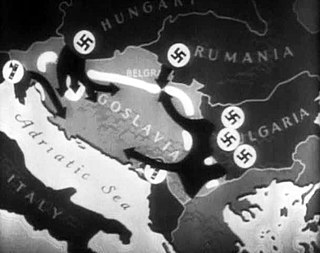
The Yugoslav order of battle before the invasion of Yugoslavia includes a listing of all operational formations of the Royal Yugoslav Army, Royal Yugoslav Army Air Force and Royal Yugoslav Navy immediately prior to the World War II invasion of that country in April 1941.

The Axis order of battle for the invasion of Yugoslavia was made up of the various operational formations of the German Wehrmacht and Waffen-SS, Italian Armed Forces and Hungarian Armed Forces that participated in the invasion of Yugoslavia during World War II, commencing on 6 April 1941. It involved the German 2nd Army, with elements of the 12th Army and a panzer group combined with overwhelming Luftwaffe support. The eighteen German divisions included five panzer divisions, two motorised infantry divisions and two mountain divisions. The German force also included two well-equipped independent motorised regiments and was supported by over 800 aircraft. The Italian 2nd Army and 9th Army committed a total of 22 divisions, and the Royal Italian Air Force had over 650 aircraft available to support the invasion. The Hungarian 3rd Army also participated, with support from the Royal Hungarian Air Force.
The 1st Army Group was a Royal Yugoslav Army formation mobilised prior to the German-led Axis invasion of Yugoslavia in April 1941 during World War II. It consisted of the 4th Army, 7th Army, and the 1st Cavalry Division, which was the army group reserve. It was responsible for the defence of northwestern Yugoslavia, with the 4th Army defending the eastern sector along the Yugoslav–Hungarian border, and the 7th Army defending the western sector along the borders with Germany and Italy. Like all Yugoslav formations at the time, the 1st Army Group had serious deficiencies in both mobility and firepower as well as internal friction among the different ethnic groups, particularly between Serbs and Croats.

The 4th Army was a Royal Yugoslav Army formation mobilised prior to the German-led Axis invasion of the Kingdom of Yugoslavia during World War II. It was drawn from the peacetime 4th Army District. When mobilised, it consisted of three divisions, a brigade-strength detachment, one horse cavalry regiment and one independent infantry regiment. It formed part of the 1st Army Group, and was responsible for defending a large section of the Yugoslav–Hungarian border, being deployed behind the Drava river between Varaždin and Slatina. Like all Yugoslav formations at the time, the 4th Army had serious deficiencies in both mobility and firepower.
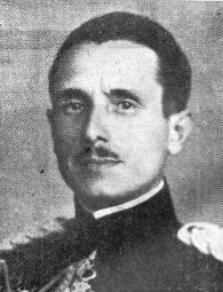
The 5th Army was a Royal Yugoslav Army formation which commanded five divisions and two independent detachments during the German-led Axis invasion of the Kingdom of Yugoslavia in April 1941 during World War II. It was commanded by General Vladimir Cukavac, and was responsible for the Romanian and Bulgarian borders between the Iron Gates and the Greek border.
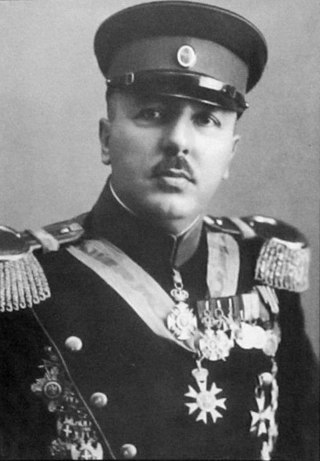
The 7th Army was a Royal Yugoslav Army formation raised prior to the German-led Axis invasion of Yugoslavia in April 1941, during World War II. It consisted of two divisions, two brigade-strength mountain detachments, and a brigade-strength infantry detachment. It formed part of the 1st Army Group, and was responsible for the defence of Yugoslavia's north-western frontier with Italy and Germany. Like all Yugoslav formations at the time, the 7th Army had serious deficiencies in both mobility and firepower.
The 42nd Infantry Division Murska was an infantry formation of the Royal Yugoslav Army that formed part of the 4th Army during the German-led Axis invasion of the Kingdom of Yugoslavia in April 1941. It did not have a corresponding divisional district in peacetime, and was raised at the time of mobilisation. Like all Yugoslav infantry divisions of the time, it was a very large and unwieldy formation which was almost entirely reliant on animal transport for mobility, and also lacked modern arms and sufficient ammunition. Commanded by Divizijski đeneral Borisav Ristić, it was largely manned by Croat troops, many of whom saw the Germans as potential liberators from Serbian oppression.

The 32nd Infantry Division Triglavski was a short-lived Royal Yugoslav Army infantry formation raised prior to the German-led Axis invasion of the Kingdom of Yugoslavia in April 1941. It was largely mobilised from the Dravska military district, and, like all Yugoslav infantry divisions of the time, was a very large and unwieldy formation which was almost entirely reliant on animal transport for mobility. Commanded by Divizijski đeneral Dragiša Pandurović and largely manned by Slovene troops, the division also lacked modern arms and sufficient ammunition.

The 1st Cavalry Division of the Royal Yugoslav Army was established in 1921, soon after the creation of the Kingdom of Serbs, Croats and Slovenes, which became the Kingdom of Yugoslavia in 1929. In peacetime it consisted of two cavalry brigade headquarters commanding a total of four regiments. It was part of the Yugoslav 1st Army Group during the German-led World War II Axis invasion of Yugoslavia in April 1941, with a wartime organisation specifying one cavalry brigade headquarters commanding two or three regiments, and divisional-level combat and support units.
The Order of battle, Keren 1941 shows Italian army forces that participated in the Battle of Keren from February to March 1941 and British troops in Sudan on 20 January 1941, which participated in military operations against Eritrea during the East African Campaign 1940–1941.
The 38th Infantry Division Dravska was a short-lived Royal Yugoslav Army infantry formation raised prior to the German-led Axis invasion of the Kingdom of Yugoslavia in April 1941. It was largely mobilised from the Dravska divisional district, and, like all Yugoslav infantry divisions of the time, was a very large and unwieldy formation which was almost entirely reliant on animal transport for mobility. Commanded by Divizijski đeneral Čedomir Stanojlović and largely manned by Slovene and ethnic German troops, the division also lacked modern arms and sufficient ammunition to meet the German onslaught.
The 162nd Infantry Division(162. Infanterie-Division) was an infantry division of the Heer of Nazi Germany's Wehrmacht during World War II.

The 72nd Infantry Regiment "Puglie" is an inactive unit of the Italian Army last based in Albenga. Formed in 1862 the regiment is part of the Italian Army's infantry arm and named for the region of Apulia.













